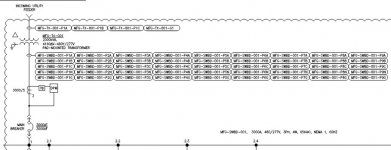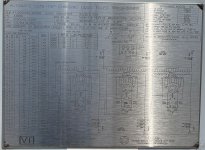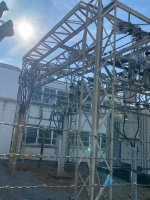johnj0745
Member
- Location
- Atlanta, GA
- Occupation
- Electrical Engineer
I am designing an electrical line-up with a 4160V Delta -480V Wye , 2000kVA Pad-Mounted Transformer that is fed from a utility owned 46kV Delta -4160V Wye, 7000kVA transformer. I am wondering what are the specific Service entrance requirements that I need to follow for this facility that's located in Huntsville, Alabama? Also, on the secondary of the 2000kVA Transformer I am feeding a 3000A, 480V, 3P, 4W switch board with 9 Sets of 4-1/C 750 kcmil cables w/#2/0 Gnd (A-Phase, B-Phase, C-Phase, Ground, Neutral) that are being routed in a 9-4" PVC 3000PSI Concrete duct bank ~20' away.
1. Do I have to have neutral cable off the secondary of the transformer to the switchboard because it's considered a "service entrance"? The meter is actually on the utility transformer itself not on the actual pad mounted transformers. I read somewhere that I can have the ground serve as the "Neutral". Think this term was "grounded neutral"? Or possibly I could run the neutral to the Main breaker that is 4-Wire breaker and remove the neutral bus since I don't have any 277V loads? Trying to save some money anyway I can.
2. Can I use NEC Table B.310.15(B)(2)(7) to derate the cables in the duct bank from the transformer to the switchboard? It calls for 6 electrical ducts but I have 9. Also, is this the right table to use? I am planning on using single conductor cables and running (A-Phase, B-Phase, C-Phase, Ground, Neutral) in each conduit.
3. Is a #2/0 ground in each conduit sufficient on the secondary size of the transformer? I plan to tie the ground for the transformer and the switchboard to the ground grid utilizing a 4/0 however I just need to confirm the ground sizing in each conduit in the duct bank is sufficient. I heard there might be specific requirements for service entrance grounds. Also, I am not sure if the "full size ground rule" applies here since there's technically no upstream protection other than fuses on the primary.
1. Do I have to have neutral cable off the secondary of the transformer to the switchboard because it's considered a "service entrance"? The meter is actually on the utility transformer itself not on the actual pad mounted transformers. I read somewhere that I can have the ground serve as the "Neutral". Think this term was "grounded neutral"? Or possibly I could run the neutral to the Main breaker that is 4-Wire breaker and remove the neutral bus since I don't have any 277V loads? Trying to save some money anyway I can.
2. Can I use NEC Table B.310.15(B)(2)(7) to derate the cables in the duct bank from the transformer to the switchboard? It calls for 6 electrical ducts but I have 9. Also, is this the right table to use? I am planning on using single conductor cables and running (A-Phase, B-Phase, C-Phase, Ground, Neutral) in each conduit.
3. Is a #2/0 ground in each conduit sufficient on the secondary size of the transformer? I plan to tie the ground for the transformer and the switchboard to the ground grid utilizing a 4/0 however I just need to confirm the ground sizing in each conduit in the duct bank is sufficient. I heard there might be specific requirements for service entrance grounds. Also, I am not sure if the "full size ground rule" applies here since there's technically no upstream protection other than fuses on the primary.




